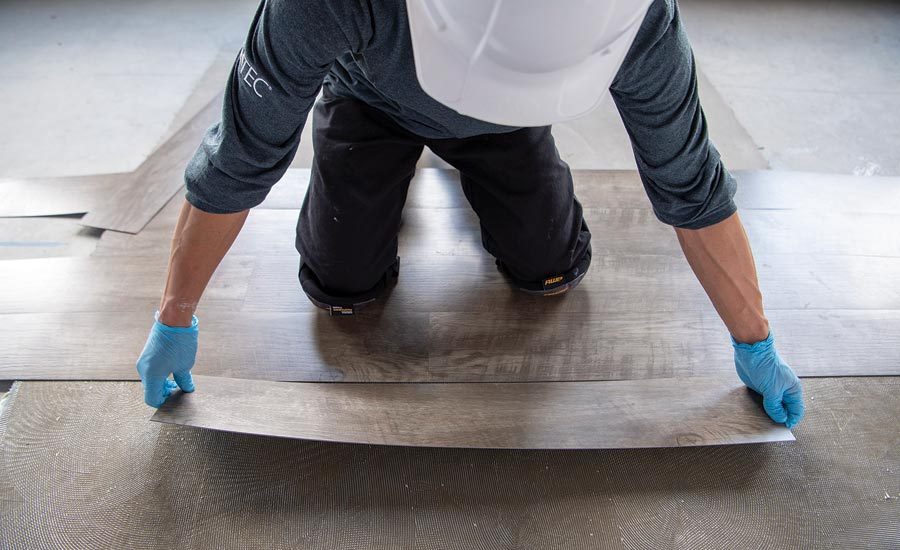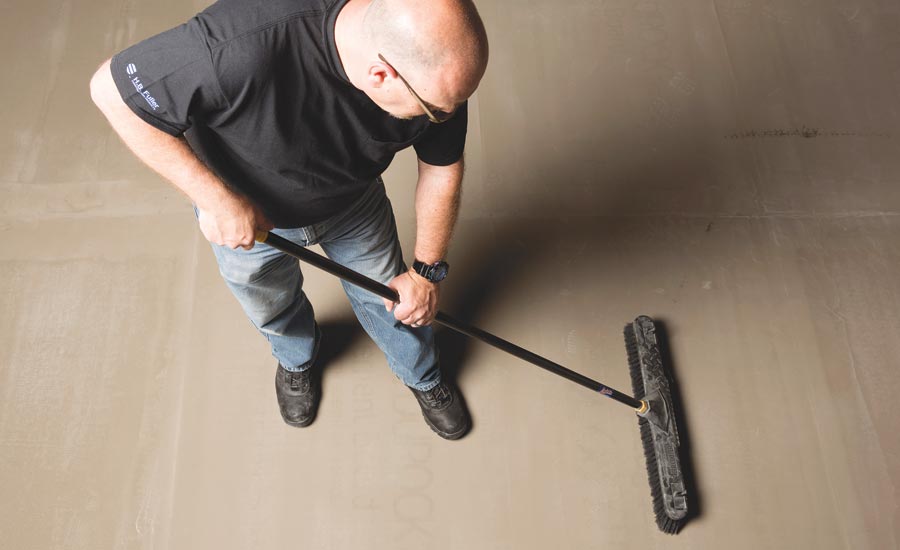Floor Prep More Critical than Ever for LVT/LVP










The growing popularity of luxury vinyl tile and luxury vinyl plank (LVT/LVP) flooring shows no sign of slowing down. As with any “hot” trend, established suppliers and new entrants have rushed in to capitalize on the booming business. LVT/LVP options have grown exponentially in the last few years. So many luxury vinyl products and different manufacturers mean contractors and buyers alike must choose carefully and make sure to follow specific instructions. Floor preparation is a large part of LVT/LVP installation and more critical than ever. In fact, floor prep can take greater than 70% of an installer’s time on a project. All LVT/LVP flooring shares the need for the substrate to be perfectly flat to perform properly. While every step of the LVT/LVP project is important, proper floor preparation can help avoid problems, save time and money, and ensure owners are satisfied with their floors.
The first step is to choose the right LVT/LVP product for the installation. Many of the LVT/LVP products on the market deliver the advantages that have made the category so successful. Owners can choose designs that look like high quality natural wood, marble or stone. Advances in printing techniques have led to LVT/LVP with intricate graphic patterns that create endless possibilities for designers and owners. Installed floors are resistant to stains, water and scuffs or scratches. At affordable prices for high quality products, LVT/LVP flooring is a great alternative to more expensive natural materials. However, buyers and contractors need to make sure they choose luxury vinyl that comes from a known supplier. With more than 80% of LVT/LVP being imported from countries with less stringent manufacturing standards than the U.S., a warranty from a reputable manufacturer protects all parties involved. Another consideration in choosing the floor is the specific requirements of the product. The fit of the specific LVT/LVP for each job must be evaluated, since each product has different installation requirements and instructions. The contractor must be sure to follow the manufacturer’s exact directions to avoid problems.
Manufacturers are very specific about the substrates and the installation techniques for their LVT/LVP floors. Preparing approved substrates can be the most important part of the installation process. Overall, floor prep brings the substrate quality up to the level necessary for a successful installation. Making the substrate perfectly flat is a key goal. Be sure to check the manufacturer’s instructions as to which substrates are suitable for the LVT/LVP chosen. There are some general best practices for the most common substrates. A concrete substrate must be at least 28 days old, to ensure it is fully dried and cured. Every concrete substrate should be tested for moisture content using the RH method. This method is recommended over the Calcium Chloride method, because it measures the moisture within the slab and not just on the surface. Moisture vapor barriers can be applied if moisture is expected to be an issue in the future.
Wood substrates receiving LVT/LVP must be assessed for height variances. If variances exist, they can be smoothed with a patch or leveling product. Installing LVT/LVP over a wood substrate may lead to unacceptable sound transference. Sound reduction standards vary for different types of jobs and locations. Contractors should check local soundproofing requirements. Either sheet products or coating underlayments can reduce sound. Installing LVT/LVP over tile or stone surfaces requires filling in the grout joints and height variances across the floor. Embossing levelers or patch products can successfully flatten tile or stone substrates. Again, sound transference may be an issue to be mitigated.
Cleaning the surface of the substrate is always the first step in prepping to install LVT/LVP. It is important to note that there are two major types of LVT/LVP products with separate installation requirements — direct glue down and snap together flooring. Both need the substrate to be flat, generally defined as varying less than 1/8” across four feet. To clean the substrate surface, first remove all loose dirt or debris. Next, smooth the surface. Any remnants of compounds such as old adhesive must be mechanically removed or hand-scraped off. Removing contaminants is especially critical when the LVT/LVP is glued down, because the remnant products can interfere with the new adhesive’s bond or cause the new adhesive to later release.
Any cracks, divots or gaps can be remedied by applying a patch or leveling product. The latest trend in leveling products is the introduction of new high-flow, self-leveling compounds. Older hand-held troweled patch products or skim coats are being replaced by these new entries. The new products can patch or level surfaces from as thin as 1/8” to 3/16”, and up to 2”. As high flow products, these self-levelers efficiently pour on or are pumped on to cover and flatten the surface, readying it for LVT/LVP installation. Installers can proceed with the installation quickly, since the coated surface is walkable in just a few hours. If the LVT/LVP flooring is glue down, additional dry time may be required. Additionally, the glue down luxury vinyl requires a primer before installation, to ensure a good bond to the substrate.
See more of the latest techniques and products for installing resilient flooring
Good floor preparation and installation practices mitigate most of the common problems seen with LVT/LVP installations. Flooring issues that result from poor product quality or poor manufacturer instructions, can be eliminated by choosing reputable products. However, an installer’s inexperience, shortcuts or inability to follow manufacturer instructions makes problems inevitable. The most common problems with LVT/LVP installations are visible high spots, adhesive failure and buckling or gapping due to excessive flooring movement. Since luxury vinyl is inherently bendable and installation is directly over the substrate, the finished floor shows any surface height variances in the underlayment. High spots telegraphing through the vinyl will wear much faster than lower areas. Preparing a completely flat surface before installation avoids this issue. Careful floor prep also helps lessen any adhesive failure for luxury vinyl. Glue down LVT/LVP fails quickly if the substrate is not cleaned properly or primed. Also, use of incorrect adhesive causes failures.
LVT/LVP flooring problems due to floor movement are much more complex. Movement happens from temperature changes, lack of product acclimation, poor installation practices and more. Temperature change is a critical issue for luxury vinyl. Vinyl material expands and contracts with heat and cold. Though temperature changes are unavoidable, best practices for floor prep and installation can eliminate most issues. Controlling the climate for the floor installation from the moment the LVT/LVP product is delivered, will keep expansion and contraction to a minimum. To avoid buckling or gapping from exposure to sunlight, identify the areas that will get sun. Install the LVT/LVP so the seams run in the same direction as the sunlight entering the area. Also, always install LVT/LVP with a perimeter gap as directed in the manufacturer’s instructions to allow for heat expansion.
When installers use best practices for LVT/LVP flooring, including following all manufacturer instructions, the floors look great and perform well. Proper floor preparation is the most time consuming but also the most important aspect of the installation. A clean, flat substrate is the right start for the LVT/LVP installation, helping to ensure that the installer and owner end up with an exceptional luxury floor.
Looking for a reprint of this article?
From high-res PDFs to custom plaques, order your copy today!














